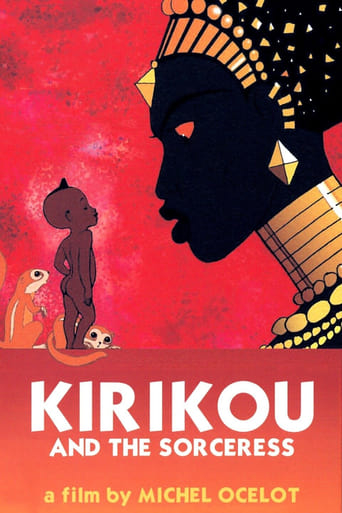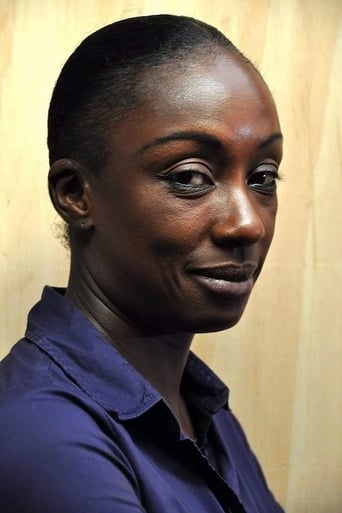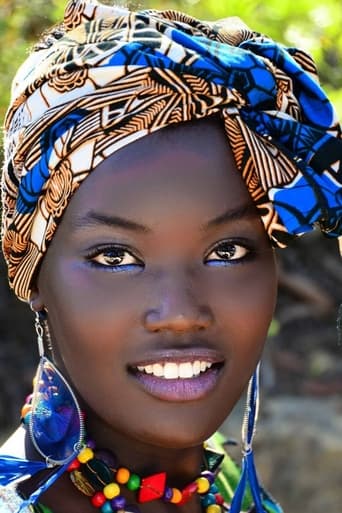Kirikou and the Sorceress (1998)
Drawn from elements of West African folk tales, it depicts how a newborn boy, Kirikou, saves his village from the evil witch Karaba.
Watch Trailer
Cast
Similar titles
Reviews
Touches You
A different way of telling a story
While it doesn't offer any answers, it both thrills and makes you think.
It’s sentimental, ridiculously long and only occasionally funny
It's no surprise that this animated adventure is mostly culled from old West African legends, as it plays like a straightforward, unflinching fairy tale. Completely absurd notions, like the infant protagonist emerging at a dead sprint from his mother's womb, are dismissed offhand in the same vein as Little Red Riding Hood's incognito wolf. That fundamental acceptance frees up the storyline to be as wildly adventurous as it likes, and coats the whole endeavor in a veil of whimsy and charm. The result is a yarn on par with Miyazaki and Disney, although the uneven animation quality ultimately keeps it from reaching those lofty heights. At times it's as beautiful and fluid as the best western animation, with a style and panache all its own, but that dedication rarely lasts long. Bright, innocent and optimistic, it's solid fare for open-minded families who don't mind navigating a sea of topless native tribeswomen.
Kirikou is by far one of the most unique characters I have yet to come across in a film or a book. For one, who ever heard of a baby that decided on his own that he was ready to come out from his mother's womb? In addition, Kirkou has a mind of his own and makes it his goal to get rid of the sorceress. However, I think it was very wise for the writer of this film to ensure that once Kirikou found the reason for the Karaba's agony and sufferings, Kirokou then understood them to be accidental and had to put an end to them. The graphics were beyond belief beautiful and the personality of each character were spot on. Karaba had a mystical voice which sounded purely evil and her hair was not unlike that of Medusa's. The warthog was also greatly reminiscent of Pumba from the The Lion King. Kirikou's journeys through the ground and around the mountain were nonetheless entertaining. His antics of camouflaging as a bird and constantly asking "but why?" were warming. The illustrations of the different sizes of the women was greatly acknowledged, for it is well known that women come in all shapes and sizes. The tree that was put into the forest by Karaba was much like the Tree of Good and Evil in the book of Genesis, representing temptation at its finest. I especially enjoyed the lessons put forth in the film, particularly from the grandfather.If you enjoyed this film, I highly suggest you check out The Secret of Kells. It's an animated fantasy about a boy who discovers the Irish Book of Kells, which does in fact exist.
Kirikou is the story of an African boy in a small town that in the end proves that you do not need to be of great stature to be an important asset to your community. Although Kirikou was unbelievably tiny, he saw things that others did not. He was able to see the true problems with Karaba the sorceress. When the watering hole no longer produced water, Kirikou went right to the source of the problem and fixed it himself. He was unlike the other people in his village; instead of fearing and complaining about Karaba the sorceress, Kirikou sought a way to fix the problems Karaba had caused for the people of the village.The fact that this film is a cartoon drastically changed the way in which I perceived the message that it was relaying to the viewer. By using animation the viewer is much more able to focus on the points that the story is making socially about modernity versus tradition. Because almost every person in this story is partially nude I think that the important social commentary that Kirikou has made might be lost on some audiences. In America we are not used to seeing as much nudity as is exposed in this film, especially in a story that is intended for children, so in my opinion it is nice that this film is a cartoon as opposed to real actors and actresses. I do not think that this film would have been nearly as helpful in the understanding of the struggles that African's have with modernity if real people were used as opposed to the cartoons that were. For example the men of the village have all been taken by the sorceress Karaba and are being used as her slaves. They represent modernity because they have been transformed into robots. This is a not so subtle way of showing the evils associated with modernity as seen by the African people.Anyone that enjoys films like the Lion King or Aladdin will love Kirikou. The thing that I found most interesting about this film was that it gave American's a way to see what stories African's use to teach their children lessons. In America we use animated films to teach kids lessons much the same as they do in Africa. The main differences between the two are the lessons that are taught. I thought it was fascinating how Ocelot taught such an important lesson to children and people alike with the use of animated people in Kirikou and the Sorceress.
Kirikou et la Sorciere was about an infant that had to fight the Sorceress in order to save his village. He uses courage to do so and he showed that size didn't matter. The most interesting theme of the movie was tradition VS modernity.In the movie Kirikou's village was one of the major settings. The village was very traditional. The men were the brave ones and the women were the scarred home makers. The women took over the care of the home and the children. The men went to fight the Sorceress. The men fought the Sorceress to prove themselves like the men in Kirikou's family did. The women in the village wore very traditional clothing too. They didn't wear shirts or shoes, but they did wear long wrap skirts around their waists. The men only wore short skirts. The village lighting was bright and warm.Another major setting was the Sorceress's land. Outside of the Sorceress's hut there were modern fetishes that protected the hut and the Sorceress. They were very modern. They were like robots. The Sorceress also wore a lot of Jewelry. She had a lot of gold because she took it away from the villagers. She was brave and strong like a man which isn't traditional in the village. At first she also didn't want to marry which again isn't traditional. She wore a wrap like the people in the village but it was gold instead of the earthy tones of the women's skirts in the village. The Sorceress's land was light in a way that looked dark and cold.In the end tradition wins. Kirikou returns to the village with the Sorceress. He makes her his girlfriend. She gives into tradition because she wants to be with a man instead of by herself like she used to. The men that the Sorceress "ate" were also freed and they returned to the village to the waiting women. The Sorceress isn't as powerful as she had been. She was able to make Kirikou a man, but that was about it. She was a woman so traditionally she would make her significant other a man. Other than that she had no power like the women in the village. The Sorceress gives up modernity and returns to the traditional village. The whole story is very interesting because of the theme of modernity VS tradition. I would recommend this film to anyone person interested in films that take a closer look at the struggle between tradition and modernity. All together the movie was very enjoyable because of the themes and because of the comical dialect. I will be watching more movies like this in the future.






